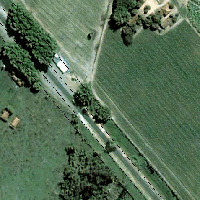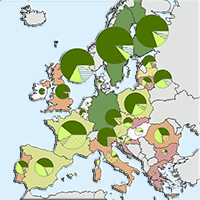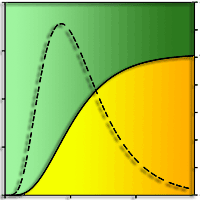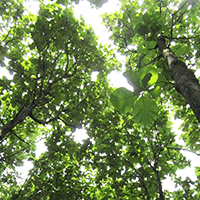
Heuristic forest planning model for optimizing timber production and carbon sequestration in teak plantations
María Alejandra Quintero-Méndez (1) , Mauricio Jerez-Rico (2)
iForest - Biogeosciences and Forestry, Volume 10, Issue 2, Pages 430-439 (2017)
doi: https://doi.org/10.3832/ifor1733-009
Published: Mar 24, 2017 - Copyright © 2017 SISEF
Research Articles
Abstract
We developed a forest planning model integrating two operational scales (single-stand and forest levels) for the optimization of timber production and carbon sequestration in forest teak (Tectona grandis L. f.) plantations. At the stand level, growth and yield simulations using a heuristic thinning optimizer provided a set of near-optimal thinning regimes for individual stands differing on initial spacing and site quality, given biological, silvicultural, and financial constraints. The set of near-optimal thinning regimes obtained were then used as input of the forest-level model, which generated optimal harvest plans for the whole plantation by simultaneously maximizing the net present value of merchantable wood and carbon sequestration. The net amount of carbon captured by the biomass and the emissions produced by decomposition of woody debris and timber products after harvest were estimated. The growth and yield model was based on a system of differential equations incorporating heuristics (genetic algorithms) to optimize age and intensity of thinnings. The full model can handle the optimization of harvest schedules for projects up to 10.000 ha and 200 stands and was tested on a validation dataset including teak plantations from Venezuela and other Latin American countries. Results indicated that regimes favoring carbon sequestration reduce the benefits of timber production, and equal profitability of carbon sequestration and timber production was obtained for carbon prices over 40 $US Gg-1. Sensitivity analysis showed that the proposed model is sensible to variation in growth rates, carbon and timber prices, and production quotas, and barely sensible to harvest and transport costs. The developed model has a modular structure that allows its calibration to incorporate data from a wide range of management regimes for teak and other forest species.
Keywords
Forest Planning, Harvest Scheduling, Optimization, Heuristics, Carbon Sequestration, Tectona grandis
Authors’ Info
Authors’ address
Escuela de Ingeniería Forestal, Facultad de Ciencias Forestales y Ambientales. Universidad de Los Andes, Mérida 5101 (Venezuela)
Centro de Estudios Forestales y Ambientales de Postgrado, Facultad de Ciencias Forestales y Ambientales. Universidad de Los Andes, Mérida 5101 (Venezuela)
Corresponding author
Paper Info
Citation
Quintero-Méndez MA, Jerez-Rico M (2017). Heuristic forest planning model for optimizing timber production and carbon sequestration in teak plantations. iForest 10: 430-439. - doi: 10.3832/ifor1733-009
Academic Editor
Giorgio Matteucci
Paper history
Received: Jun 05, 2015
Accepted: Oct 30, 2016
First online: Mar 24, 2017
Publication Date: Apr 30, 2017
Publication Time: 4.83 months
Copyright Information
© SISEF - The Italian Society of Silviculture and Forest Ecology 2017
Open Access
This article is distributed under the terms of the Creative Commons Attribution-Non Commercial 4.0 International (https://creativecommons.org/licenses/by-nc/4.0/), which permits unrestricted use, distribution, and reproduction in any medium, provided you give appropriate credit to the original author(s) and the source, provide a link to the Creative Commons license, and indicate if changes were made.
Web Metrics
Breakdown by View Type
Article Usage
Total Article Views: 53186
(from publication date up to now)
Breakdown by View Type
HTML Page Views: 42085
Abstract Page Views: 3182
PDF Downloads: 6552
Citation/Reference Downloads: 42
XML Downloads: 1325
Web Metrics
Days since publication: 3220
Overall contacts: 53186
Avg. contacts per week: 115.62
Citation Metrics
Article Citations
Article citations are based on data periodically collected from the Clarivate Web of Science web site
(last update: Mar 2025)
Total number of cites (since 2017): 14
Average cites per year: 1.56
Publication Metrics
by Dimensions ©
Articles citing this article
List of the papers citing this article based on CrossRef Cited-by.
References
Optimización de la plantación forestal considerando la captura de carbono en bosque de pino-encino en la sierra Suárez, Oaxaca, México [Optimizing the plantation forest considering carbon capture in the pine-oak forest in Suárez range, Oaxaca, México]. Universidad Politécnica de Madrid, Escuela Técnica Superior de Ingeniero de Montes, Madrid, Spain, pp. 174. [in Spanish]
Gscholar
Modelo preliminar para la planficación del aprovechamiento en plantaciones forestales industriales en Venezuela [Preliminary harvest planning model for industrial forest plantations in Venezuela]. Interciencia 33: 802-809. [in Spanish]
Gscholar
Fijación de carbono en plantaciones de melina (Gmelina arborea Roxb.), teca (Tectona grandis L. f.) y pochote (Bombacopsis quinata Jacq.) en los cantones de Hojancha y Nicoya, Guanacaste, Costa Rica [Carbon fixation in melina (Gmelina arborea Roxb.), teak (Tectona grandis L. f.) and pochote (Bombacopsis quinata Jacq.) plantations in the cantons of Hojancha and Nicoya, Guanacaste, Costa Rica]. Escuela de Ciencias Ambientales, Facultad de Ciencias de la Tierra y el Mar, Universidad Nacional, Heredia, Costa Rica, pp. 95. [in Spanish]
Gscholar
La Teca en América Latina [Teak in Latin America]. In: “Plantaciones de Teca, Mitos y Realidades” [Teak plantations, Myths and realities] (De Camino R, Morales JP eds). CATIE, Costa Rica, pp. 30-41. [in Spanish]
Gscholar
Orientación de buenas prácticas para uso de la tierra, cambio de uso de la tierra y silvicultura. Programa del IPCC sobre inventarios nacionales de gases de efecto invernadero [Best practices orientation for land use, land use change and silviculture. IPCC Program on greenhouse gas national inventories]. World Meteorological Organization, Geneva, Switzerland, pp. 628. [in Spanish]
Gscholar
Curvas de índice de sitio basadas en modelos mixtos para plantaciones de teca (Tectona grandis L. F.) en los llanos de Venezuela [Site index curves based on mixed models for teak (Tectona grandis L. F.) plantations in the Venezuelan plains]. Agrociencia 45: 135-145. [in Spanish]
Gscholar
Simulador de crecimiento y secuestro de carbono para plantaciones de teca en Venezuela: una aplicación en SIMILE [Growth and carbon sequestration simulator for teak plantations in Venezuela: an application in SIMILE]. Bosque 36: 519-530. [in Spanish]
CrossRef | Gscholar
Modeling and analyzing timber production and carbon sequestration values of forest ecosystems: a case study. Polish Journal of Environmental Studies 16: 473-479.
Gscholar
La teca y su importancia económica a nivel mundial [Teak and its economic importance at the world level]. In: “Plantaciones de Teca, Mitos y Realidades” (De Camino R, Morales JP eds). CATIE, Costa Rica, pp. 8-28. [in Spanish]
Gscholar
Determinación de ecuaciones de volumen para plantaciones de teca (Tectona grandis L.) en la unidad experimental de la Reserva Forestal Caparo, Estado Barinas - Venezuela [Determining volume equations for teak plantations (Tectona grandis L.) in the experimental unit of the Caparo Forest Reserve, Barinas State - Venezuela] Revista Forestal Venezolana 42: 41-50. [in Spanish]
Gscholar
Regímenes de espesura y sus efectos en la rentabilidad de teca (Tectona grandis L.f) en Caparo, Venezuela [Stocking regimes and their effects in teak (Tectona grandis L. f) profitability in Caparo, Venezuela]. Universidad de Los Andes, Facultad de Ciencias Forestales y Ambientales, Centro de Estudios Forestales y Ambientales de Postgrado, Mérida, Venezuela, pp. 98. [in Spanish]
Gscholar
Stand growth scenarios for Tectona grandis plantations in Costa Rica. Academic Dissertation, University of Helsinki, Finland, pp. 77.
Gscholar
Modelización del secuestro de carbono en sistemas forestales: efecto de la elección de especie [Modeling of carbon sequestration in forest systems: effect of species selection]. Ecología 21: 341-352. [in Spanish]
Gscholar
Métodos heurísticos en la planificación del manejo forestal: un ejemplo de aplicación [Heuristics methods for forest management planning]. Revista Forestal Venezolana 54: 183-194. [in Spanish]
Gscholar
Evaluación de tres técnicas heurísticas para resolver un modelo de planificación del aprovechamiento en plantaciones forestales industriales [Evaluating three heuristic techniques for solving a harvest planning model for industrial forest plantations]. Interciencia 36: 348-355. [in Spanish]
Gscholar
Modelo de crecimiento y rendimiento para plantaciones de teca (Tectona grandis L.) usando el enfoque de espacio de estados [Growth and yield model for teak plantations (Tectona grandis L.) based on the space-state approach]. Revista Ciencia e Ingeniería 33: 33-42. [in Spanish]
Gscholar

















